Fairies
Basic Information
Anatomy
Fairies are a bipedal, insectoid species possessing four arms, two legs, and four wings. Their body is divided up into the head, thorax, hips, and abdomen. Only workers, soldiers, and drones possess venom sacks and stingers, filled with a hallucinogenic venom.
Genetics and Reproduction
The breeding season occurs twice a year, in the early spring and mid fall, during the time when most of the workers and soldiers are still in hibernation or just entering it. Queens and Drones will produce strong pheromones signalling they are ready to breed, the pheromones from the queen reaching males miles away to flock to her. In Drones, these pheromones will allow him to pass into the nest safely, without coming under attack by any soldiers not hibernating, and the Queen will leave the safety of her brooding chamber at the heart of the nest to mate.
As drones gather around a colony or close in on a virgin queen, they will begin to fight with one another for breeding rights. These battles are rarely deadly, with drones quickly giving up when wounded. In many cases, this is the only time a fairy may turn their stinger on their own kind outside of territorial skirmishes, with the drones using their incapacitated opponents as a gift for the Queen they wish to mate with. These drones are often killed and eaten by the queen. Smaller and weaker drones will often use the distraction of these battles to sneak into colonies to mate with the royal workers in secret. Those that are caught are often killed by the Queen, as are any royal workers who she catches mating with him.
Virgin Queens, those who have not bred or started a colony of their own, will perform mating flights with Drones, testing his physical abilities. Those who pass are allowed to mate with her, and he will stay with her throughout the season until the colony's first workers are mature, at which point he will leave. Drones are at risk when breeding, as Queens are highly aggressive and aggravated during the breeding season. Queens will readily kill drones that irritate them or overstay their welcome and devour them. If a drone does manage to survive mating, he will quickly leave the colony entirely. Curiously, drones that live to be about 100 years will become queens themselves. Notably, Queens that were once Drones are known to be even pickier with the drones they mate with, and even more aggressive to ones that linger, possibly as they know he will try to mate with royal workers if given the chance.
After mating, Virgin Queens will have to begin building their first nest quickly, as in a few weeks they will molt and shed their wings, never to be grown again in their lives. Their shed wings are most often the first food for the fungus they grow in the colony, jump starting the process. Any drones she has killed will be added to the pile to feed the quickly growing colony. Queens will lay eggs year round after mating, laying tens of thousands throughout their lives. A queen's first eggs will become her royal workers, who will tend to her so she can focus on having more offspring, who will become the soldiers and workers of the colony. Eggs are placed in the larval chambers by workers to hatch, and once a larva matures into a pupae, is added to the brooding chamber.
Growth Rate & Stages
Fairies have many development stages, metamorphisizing at crucial points in their lives depending on environmental factors. The loss of a queen, major habitat change, or dietary changes can cause a fairy to change from one stage to another. Their species has a caste system, of larva, pupae, workers, soldiers, Queens, and Drones. Soldiers and workers typically live about 80 years, however Queens can live as long as 300.
Caste System
Larva- Infant fairies. They are completely dependent on workers for sustenance, warmth, and safety. A few times a year, a Queen will produce Royal Larva, or larva that will grow into Queens and Drones. They are highly prized, and the most protected of the colony. Pupae- These are infant fairies in transition to adulthood, and also fairies transitioning to a new caste. They are dependent on workers much like larva. Workers- sterile, adult fairies. Workers are the smallest of the castes, and are the primary gatherers, hunters, and builders of a colony. Workers may become fertile queens if the previous queen dies, or if fed a special diet by drones. Soldiers- sterile adult fairies, notably larger and more aggressive than workers. Soldiers are often covered in hard, venomous spines, and the primary defenders of a colony. Soldiers may become fertile queens if the queen dies, fed a special diet by males, or separated from the colony for several months. They are the most aggressive of this already highly territorial species. Queens- Fertile adult female fairies. Queens are the largest fairies by far, and the only ones in a colony to produce offspring. They have a much larger abdomen, dominated by their reproductive organs, and a fluffy ruff of hairs around their neck that secrets pheromones unique to them and marks the colony as their own territory. It is also a signal to males that they are fertile, to aid them in finding a queen. Drones- Fertile adult male fairies. They are larger than soldiers and workers, though not quite as large as Queens. Like Queens, they posses a fluffy ruff of hairs secreting pheromones, signaling that they are capable of breeding. These pheromones also allow them to pass safely into a colony during the breeding season, as soldiers will ignore them. Males also can produce a secretion that can turn workers and soldiers into fertile Queens if fed to them over a period of time. Drones are typically solitary, unlike all other castes, only living in a colony after mating with a previously unbred queen for a season. Drones can become queens if they live over 100 years. Royal Workers- a special caste of workers whose only job is to feed, clean, and care for the Queen and her chamber in the colony. They, unlike other workers, are fertile and become Queens if mated with by a drone. These are generally the oldest of a Queen's offspring. While they don't look any different from regular workers, they spend their entire lives in the Queen's chambers, only leaving upon death or becoming a Queen themselves outside of hibernation. It is thought that Royal Workers are fertile due to that the first years of a Queen's life are the most dangerous, and she is at the most risk of dying while the colony grows, so if she does, a Royal Worker can take her place and carry on the colony.Ecology and Habitats
Fairies are found the world over aside from tundra regions, taking advantage of every habitat they can survive in. They are most common in jungles and forests, forming massive arboreal nests. In desert regions they may form their nests underground.
Nests are massive, dome or sphere shaped structures made out of a mix of plant matter and fairy saliva comparable to wasp paper. In forested regions, these are often built between trees in the canopy, or in desert regions, underground near a source of ground water. Either way, the nest has 5 primary sections- The brooding chamber, Queen's chamber, Fungus farm, larval chamber, and food stores. In particularly large colonies, the nest may have multiple brood, fungus, and larval chambers. Typically, the Queen's chamber is at the center of a nest, surrounded by a larval chamber. Wrapping around the inner section of the nest is the fungus farm, surrounded by brooding chambers and then finally the exterior of the nest. Food stores' placement in the nest vary, mostly dependent on the structure of the nest. Generally, they are placed somewhere near the entrance for easy access by workers. As the Queen and Fungus are critical to the colony's survival, they are the most fiercely guarded, with any intruders quickly killed and their corpses added to feed the fungus farm.
Dietary Needs and Habits
Fairies are omnivores, however they primarily eat a special fungus unique to growing in their nests that they cultivate with care. This fungus can only survive in the conditions in the nest, and strains of it may be unique to specific colonies. They feed the fungus all manner of matter, usually foraged plant material such as leaves and berries, although bark, carrion, and left over bones are known to be found in the fungus farms. When feeding the fungus, fairies will spit up any food they have consumed, partially digested, into piles in the fungus farms so the fungus can grow on it. They will then eat mature fungus in the colony.
When food shortages come, their fungus is at risk of dying, which will starve the entire colony as larva and pupae cannot eat anything else unlike their adult counterparts. To combat this, they become highly aggressive, and will attack anything they see on sight, from animals to other races. Some colonies have even been known to attack others of their own kind, raiding their nest for more fungus and food. Ordinarily docile (for their species) fairies can switch to being highly aggressive in a matter of days if food becomes low, so it is best to give all nests a wide berth, no matter how well relations with them are.
Some fairies have been known in desperate times to feast on anything they can, including bone, cloth, and garbage by spitting up their stomach acid to turn the item into a liquid they can digest. Those particularly desperate and starving have been observed attempting to eat rocks and other inorganic matter. Fairies in such a state are usually on the brink of death and drastically weakened, though they can still be a threat in approached unnarmed. Most Fairies who enter this state do not ever recover.
Biological Cycle
During the winter in colder regions, fairies will hibernate over winter with exception of the Queen, her Royal Workers, and Drones. Drones who have infiltrated a colony in the wintertime will breed with all available females, while the Queen and Royal Workers expand and tidy the colony, feasting on stores of food gathered all year. In the late winter and early spring, before the soldiers and workers awake from hibernation, Royal Workers turned into queens and newly molted virgin queens will leave the colony along with the drones to find mates and start their own colonies.
In the spring and the fall, breeding season begins for fairies. Drones and new virgin queens will take mating flights and begin breeding and starting new colonies.
Additional Information
Social Structure
Fairies are led by their Queen, who makes all decisions for the colony. She is both their mother and their leader, deciding which areas of a colony to expand, which to destroy, where to nest and feed, and whether or not to move the colony. As queens are also highly aggressive, she restricts breeding rights only to herself whenever possible, to prevent competition between herself and her royal workers. Queens are rarely seen by outsiders of the colony, usually only virgin queens are observed prior to building a colony.
Workers and soldiers who wish to leave the colony, or dislike their queen for whatever reason, do however have an escape in becoming queens themselves with the help of a drone feeding them a special diet secreted by him to turn them into queens. Particularly ruthless queens will have dissenting workers and soldiers killed, as well as any drones who enter the nest. In order to find a drone to transform them into queens, dissenting workers must find him while foraging without the Queen noticing their absence. Soldiers may have an easier time, as they can molt into queens if separated from their colony for several months, negating needing a drone at all aside to breed with.
Drones, the males of the species, are mostly solitary, as colonies are aggressive to them, and so are other drones. Outside of the breeding season, many drones flock to cities and population centers, as to not worry about conflict within their species. Other races note that drones are quite friendly and much less aggressive than the rest of their kind, and much more sociable. During the breeding season, much like queens, they become highly aggressive to anything that may pose competition or a threat, or in some cases, crazed, and attempt to mate with anything.
While most Fairies are friendly to their own colony, outsiders to the colony are regarded as enemies. Fairies of rival colonies will rarely cross paths, however when they do, it is usually due to food shortages, and workers will report to the soldiers any rivals they see. Soldiers will increase patrols in the area, and kill any intruders they come across. This can spark conflicts between different colonies that can last for centuries, as their Queens are long lived and do not easily let go of grudges.
Uses, Products & Exploitation
Due to their hallucinogenic venom, fairies are often harassed by thrill-seeking humanoids looking to get high. People will often disturb their colonies in order to get stung, or threaten to do so with fire and smoke. Most often, this results in their deaths, as fairies are highly protective of their nests and prone to attack to kill with their powerful bites, using their venom merely as a means to restrain their attackers.
On the flip side however, fairies also use this known use of their venom to their advantage- selling services to sting humanoids looking to get high in exchange for trade or money to feed the colony's fungus. This is especially common in colder climates, where the risk of the fungus dying is much higher every year than more temperate regions. While in most places this is illegal, it hasn't stopped the underground trade in the least.
Facial characteristics
A fairy's head is shaped like a spade, with symmetrical protrusions on the sides shaped like the bud of a flower. At the back of the head, long, flowing membranes often mimic flower species in their native region.
Geographic Origin and Distribution
Global
Average Intelligence
Not enough data, however they are at least as intelligent as humans.
Perception and Sensory Capabilities
Fairies like most insects, posses elbowed antennae as both a means of a sense of touch and scent. Their smelling capabilities go far beyond antennae however, with large, flowing membranes extending off the back of their heads. These membranes are highly sensitive, and can smell food or water nearly a mile away. They also have six compound eyes, three on each side of the head that can move independently from other sets, giving them a massive field of view depending on the direction they are looking. Fairies are capable of seeing auras and essences, due to their smallest pair of eyes being sensitive to them, however they rarely interact with them and are not known for being common magic users, like most other races that can see auras and essences.
All species of fairy are known to have an incredibly potent hallucinogenic venom. While not deadly, the hallucinogens in their venom are so potent that a victim stung by it may be left paralyzed and unable to defend themselves, in a world of bliss and incoherent. Fairies have been known to use this relentlessly in attacks, leaving their prey unawares as they are killed. They also use this as a method of trade, selling their services and venom to those seeking a good high.
Symbiotic and Parasitic organisms
Fairies share a symbiotic and necessary relationship with a species of fungus, called fairy mushrooms needed for both kind's survival. Fairies grow the fungus in their colonies and feed on it, with the fungus entirely dependent on the fairies for climate control and sustenance. Without this fungus, the colony would quickly die off, as larva and pupae cannot consume anything else.
Civilization and Culture
Naming Traditions
Among fairies, only Queens and Drones have true names in the traditional sense, that which they have given themselves. Most often, they will name themselves after the area they nest in or in the case of drones, the colony they were born from. These names can be broad and vague, or incredibly specific down to a description of the tree their colony was built upon.
Ex: Queen Waveriver, Queen Palebranch, Queen of the Russet Valley, Brokenbark, Highcliff, Burlbirch
Workers and Soldiers do not posses traditional names, rather their name is an identifier of their current position in the colony and a descriptor of the colony. These names can change many times throughout their lives, and even change back to a previous one. Long lived workers or soldiers may introduce themselves with a long string of names they've had, to show their status.
Ex: Fungus Feeder Waveriver, North Scout Palebranch, Russetvalley Nest Guardian
Beauty Ideals
Fairies consider those with clean, shiny carapaces and no rips or tears in their scent membranes to be in good health, and thus attractive. Brightly colored membranes are seen as more favorable than dull or plain ones, sometimes even damaged ones, if more brightly patterned, will be chosen over those in perfect health.
Gender Ideals
Gender is a curious subject in fairies, as soldiers and workers are completely removed from the concept of gender in a traditional sense. Queens and Drones can be thought of as the females and males of their kind respectively, however as their species is so far removed from humanoids, they have a different concept altogether, instead identifying by their caste.
Courtship Ideals
Courtship between fairies is both a brief yet complex affair. Drones seeking to mate with a Queen must wait until early spring or mid fall, when much of the colony is still in hibernation and defenses are low in order to reach the Queen. If encountering another Drone along the way, the two will battle fiercely for her affections and to prove that they are fit- hitting, biting, and on occasion even stinging one another. The losing Drone is often presented to the Queen as a gift, along with other gifts of food or adornments for her in order to placate her if she had not been fully impressed by his performance. Generally, this weaker Drone is killed and eaten. Queens who have been impressed will allow the Drone to mate with her, and the moment he is finished, will banish him from her hive, and not allow him back until the next breeding season.
Drones may often sneak in and mate 'on the side' with a Queen's royal workers while she is distracted and mating with another Drone, or steal away dissenting workers and soldiers to be turned into queens themselves.
Relationship Ideals
There is very little data on relationships between fairies within their own kind. Their relationships exist almost entirely for the sake of reproduction, and that is also where they end. Queens have no attachment to the drones they mate with and are prone to killing them if they linger around her for too long. As such, drones most often form strong and lasting relationships outside their species, however most are not sexual in nature.
Workers and Soldiers also form strong platonic bonds with their nest mates, and can be best compared to platonic life partners.
Major Language Groups and Dialects
Common
Common Etiquette Rules
Fairies have a complex social structure built upon castes, with each having their own rules and way of life. Over all, however, fairies are to be treated with the upmost respect, as their territories and colonies are most often treated as another nation entirely and subject to whatever laws their Queen sees fit to enact.
Of these laws, the most broad and encompassing of them across all hives are as follows:
Revealing the colony's location is forbidden. Starting fires, leaving trails, or deforesting an area around them is leaving them open to attack by rivals, and risks their fungus and young.
Common Dress Code
Outside of colder climates, clothing in uncommon among fairies. Instead, intricate jewelry and accessories often made of silks, metals, and vines are common. These are usually in the form of crowns, anklets and bracelets, and small capes adorning the body. Pouches and bags are marks of higher status in colonies among the workers, allowing them to carry more food and supplies back to the nest. Queens often are decorated with jewelry and accessories found or crafted by workers, gifts given to them. Some queens may be so covered in them that it hard to determine where her body ends, and her adornments begin.
Of colonies in the colder regions, clothing mostly consists of simple woven fabrics, furs, and feather or down cloaks to keep warm while gathering as winter sets in. Like other colonies, the Queens will generally have the most adornments, despite the temperature in the nest being controlled, as a symbol of status.
Common Taboos
Attacking another fairy, outside of territorial conflicts or a colony being at risk of starving is strictly forbidden. A fairy doing so even once or accidentally may start wars between colonies that can last for decades.
It is also considered a taboo for a worker or soldier to become a queen and abandon their colony, however this taboo is mostly spread by queens seeking to keep competition to a minimum. Among workers and Soldiers, this taboo is not nearly as strong, and sometimes joked about when experiencing minor inconveniences.
Perhaps the strongest taboo among fairies is anything that goes against the strict traditional caste system of a colony- Having multiple Queens, lingering Drones, and allowing fairies from other colonies to join their own. Fairy society is built upon these ideals, and most Queens adhere to them strictly and will have anyone in their colony who objects to the norm either caste out, or in the case of soldiers, killed. This has not stopped such mixed colonies from arising, however. One such colony, in Ireland called the Stag Cliff Colony, is made up of three Queens, all sisters, a harem of drones, and workers from many different colonies in the area. Due to its massive size, this colony has dominated their region and is unable to be challenged by other colonies.
History
The origins of the fae are unknown. Each hive often has their own mythology and tales of their creation that highly conflicts with that of others, many of them telling tales of originating from a single queen and her many daughters, already fully formed before the race's origins and spread. Due to their highly isolationist nature and insular culture, most fae do not agree on one singular myth, typically following that which they grew up with and passing it on to further generations.
Interspecies Relations and Assumptions
Fairies most often have fairly nuetral relationships with all other races on Terra, with three exceptions- The Arachne, the Dragons, and the Centauri Tribes.
Arachne are almost completely immune to the fairies' venom, and only race to ever have faced them in large scale combat historically, and have time and time again. These two races often fall into similar territories, and such, are rivals and enemies when it comes to resources. At times, Arachne will feed on Fairies, and Fairies have also been known in times of war to capture Arachne and force them to work in their nests.
As for the dragons, the source of fairies negativity tword them comes from the time of the War of Black Ash. During the war, many fairy colonies were raided by the dragons for food, or outright destroyed in territorial conflicts. Long and bloody conflicts between Fairies and dragons were commonplace, as were starving colonies attacking other races. The dragons, in their use of fire magic, something greatly feared by the fairies, allowed the passing of stories from Queen to workers for generations, and set a deep hatred of the dragons in their race. Many colonies are led by queens descended from those who were alive during the War of Black Ash, and still fight conflicts with them started centuries ago.
In contrast, Fairies are strong allies to the Centauri. Both of their races as a whole have had good relations and trade for millenia, forging a powerful relationship with common enemies between them. While differing from other race's allies, the relationship between Cenrauri and Fairies are more 'the enemy of my enemy is my friend.'
Lifespan
Varies
Conservation Status
least concern
Average Height
Workers- 2.5 feet
Soldiers- 3 feet
Drones- 4 to 5 feet
Queens- 6 to 7 feet
Average Physique
All castes are rather slim and agile, with a smooth carapace covering their bodies. Breeding Queens are the exception, having massive abdomens and the sole purpose of producing more offspring for a colony. Long lived queens may become so large that they cannot move on their own, entirely reliant on their workers for sustenance.
Body Tint, Colouring and Marking
As they have few natural predators or competition aside from their own kind and Arachne, fairies have little need of camouflage and come in a wide variety of colors. Natural colors, such as greens, browns, and yellows are the most common, with a trend for white, tans, and black in drier regions. Their head membranes often mimic flora from their native region, coming in spectacular colors and patterns. The patterns on their membranes are crucial to identifying one another, and any interruption of it, such as rips or tears, may result in the colony not recognizing a fairy as a member of the colony and killing them in the same manner they would an outsider.
Geographic Distribution

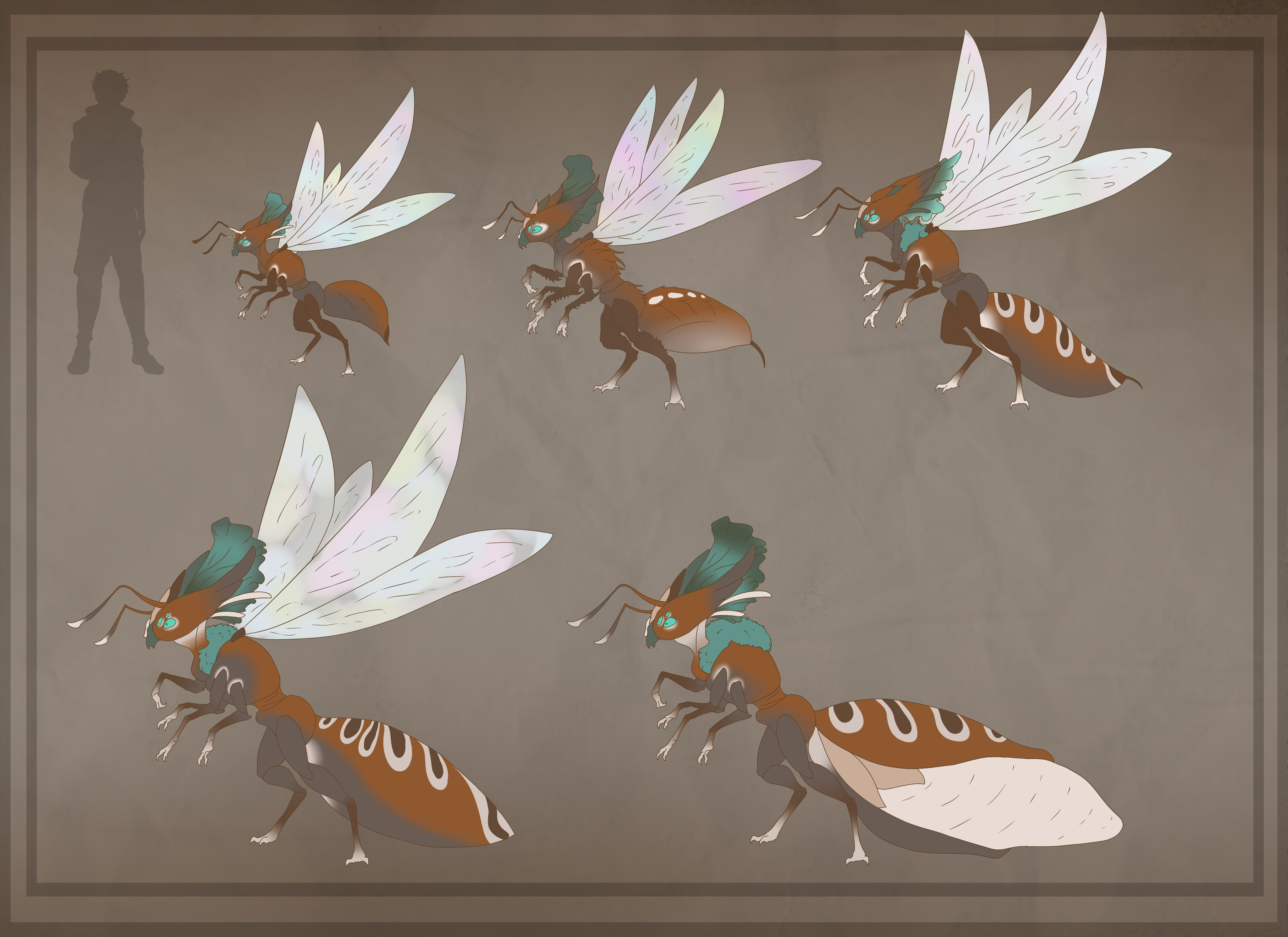

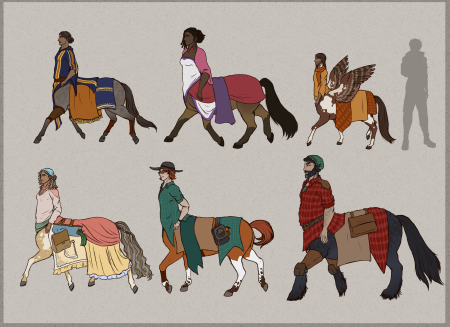
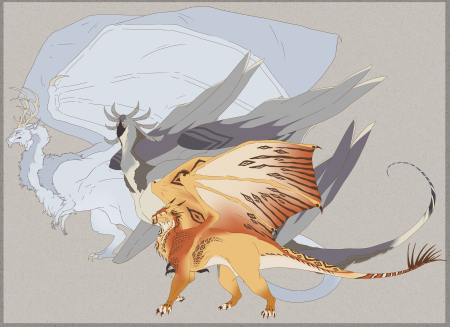
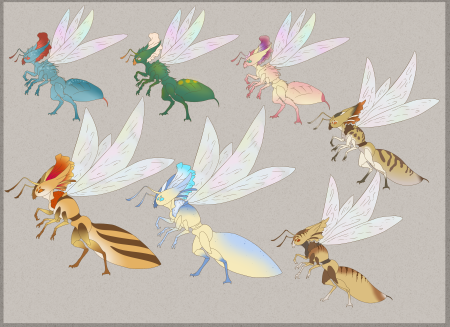
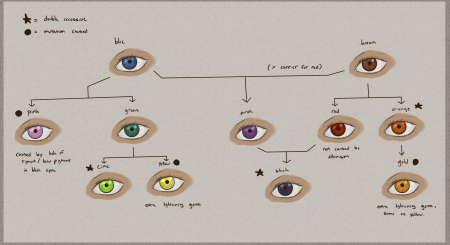
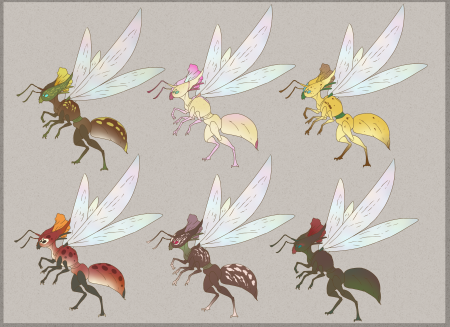
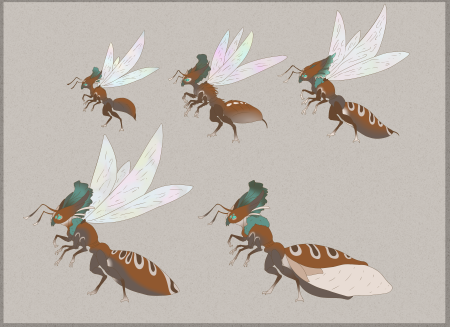
Comments